Schönborn family
.jpg)
Schönborn is a noble and mediatised former sovereign princely family from the former Holy Roman Empire. Several members of the family have held high offices of the Roman Catholic Church and the Holy Roman Empire over the course of centuries, including as Bishops, Prince-Bishops, Cardinals and Prince-Electors. In addition to several family members having been elected monarchs of ecclesiastical principalities—the Electorate of Mainz, the Prince-Bishopric of Würzburg, the Prince-Bishopric of Worms, the Prince-Bishopric of Speyer, the Electorate of Trier, and the Prince-Bishopric of Bamberg—the family possessed a fiefdom in Franconia that held imperial immediacy, and was thus a principality of the Holy Roman Empire, the state of Schönborn.
History
Schönborn appeared first in the County of Katzenelnbogen in 1373 when Gilbrecht of Schönborn, a vassal, served Eberhard V of Katzenelnbogen. Later it was a German statelet ruled by the Schönborn family located in Franconia and areas at the Main River in Germany, located to the south of Bamberg and to the southeast of Würzburg.
The Schönborn family, originally from Schönborn, Rhein-Lahn, owned several fiefs in Southern Hesse. In 1661, Philipp Erwein, Baron von Schönborn (1607–1668), of Freienfels Castle near Weinbach, since 1654 also owner of Geisenheim, the only brother of Elector-Archbishop Johann Philipp von Schönborn, purchased the Herrschaft (territory) of Heusenstamm and built a new castle. In 1671 his son Melchior (1644–1717), brother of Elector-Archbishop Lothar Franz von Schönborn, acquired the fief of Reichelsburg. His son Rudolf Franz (1677–1754) married Eleonore von Hatzfeld in 1701, widow of the Count von Dernbach, who had left her the Herrschaft Wiesentheid in Franconia, which was a small Imperial State and raised to a County in 1701. She also inherited the Austrian fiefs of Arnfels and Waldenstein in Carinthia from her first husband. Her father-in-law Melchior then bought some further estates in Austria in 1710, Göllersdorf with Mühlberg and Aspersdorf in Lower Austria, from the (then extinct) Counts of Buchheim. In 1717, his estate was partitioned into the states of Schönborn-Wiesentheid and Schönborn-Heusenstamm. Heusenstamm was inherited by Schönborn-Wiesentheid in 1801. The state of Schönborn-Wiesentheid was mediatised in 1806; the family thus retained its princely rank.
In 1726, Charles VI, Holy Roman Emperor, granted Palanok Castle with Mukacheve, Chynadiyovo and 200 villages in the Kingdom of Hungary (today part of the Ukraine) to Elector Lothar Franz who had elected and crowned him and was one of his main political supporters within the Empire. The estate, one of the largest in Eastern Europe, remained in the family well into the 20th century.
Lords of Schönborn (1385–1663)
- Gerard (1385–1416)
- Gerard (1416–1460)
- John II (1460–1490)
- John IV (1490–1529)
- George II (1529–1560)
- Philip (1560–1589)
- George IV (1589–1613)
- Philip Erwin (1613–1668), since 1663 Baron
Barons of Schönborn (1663–1701)
- Philip Erwin (1663–1668)
- John Erwin (1668–1705), since 1701 Count, jointly with:
Counts of Schönborn (1701–1717)
- John Erwin (1701–1705)
- Melchior Frederick (1705–1717)
- Divided between the lines Heusenstamm and Wiesentheid.
After German Mediatisation
- Hugo, Count 1772-1817 (1739–1817)
- Franz, Count of Schönborn-Buchheim (1768–1841)
- Schönborn-Buchheim Line
- Franz, Count of Schönborn-Wiesentheid (1776–1840)
- Schönborn-Wiesentheid Line
- Friedrich, Count 1817-1849 (1781–1849)
- Erwein, Count 1849-1881 (1812–1881)
- Karl, Count 1881-1908 (1840–1908)
- Johann, Count 1908-1912 (1864–1912)
- Karl Johann, Count 1912-1952 (1890–1952)
- Hugo-Damian, Count 1952-1979 (1916–1979)
- Philipp, Count 1979-present (born 1943)
- Count Christoph, Archbishop of Vienna (born 1945)
- Count Michael (born 1954)
- Hugo-Damian, Count 1952-1979 (1916–1979)
- Count Heinrich (1910–1991)
- Count Alexander (born 1938)
- Count Damian (born 1987)
- Count Alexander (born 1938)
- Karl Johann, Count 1912-1952 (1890–1952)
- Count Zdenko (1879–1860)
- Count Zdenko (1917–1993) - male heirs exist
- Johann, Count 1908-1912 (1864–1912)
- Franziskus von Paula (1844–1899) was a Czech Roman Catholic bishop of České Budějovice and later archbishop of Prague and cardinal.
- Karl, Count 1881-1908 (1840–1908)
- Erwein, Count 1849-1881 (1812–1881)
- Franz, Count of Schönborn-Buchheim (1768–1841)
Counts of Schönborn-Buchheim
- Francis George (1682–1756)
After German Mediatisation
- Franz, 1st Count 1817-1841 (1768–1841)
- Erwein, 2nd Count 1841-1844 (1791–1864) - resigned rights to his brother in 1844
- Karl, 3rd Count 1844-1854 (1803–1854)
- Erwein, 4th Count 1854-1903 (1842–1903)
- Friedrich Karl, 5th Count 1903-1932 (1869–1932)
- Georg 6th Count 1932-1989 (1906–1989)
- Friedrich Karl, 7th Count 1989-present (born 1938)
- Damian, Hereditary Count of Schönborn-Buchheim (born 1965)
- Count Vinzenz (born 1966)
- Count Philipp (born 2003)
- Count Clemens (born 2005)
- Count Alexander (born 2010)
- Count Vinzenz (born 1966)
- Count Theodor (born 2015)
- Friedrich Karl, 7th Count 1989-present (born 1938)
- Georg 6th Count 1932-1989 (1906–1989)
- Friedrich Karl, 5th Count 1903-1932 (1869–1932)
- Erwein, 4th Count 1854-1903 (1842–1903)
Counts of Schönborn-Heusenstamm (1717–1801)
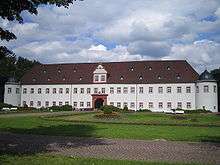
Schönborn-Heusenstamm was a German statelet ruled by the Schönborn family located in the south of modern Hesse, Germany. Schönborn-Heusenstamm was a partition of Schönborn, and was inherited by Schönborn-Wiesentheid in 1801.
- Anselm Francis (1717–1726)
- Anselm Posthumous (1726–1801)
Counts of Schönborn-Wiesentheid (1717–1806)

Schönborn-Wiesentheid was a County in Lower Franconia, the northwestern Region of modern Bavaria, Germany, comprising various isolated districts spanning from the Regnitz River to the Main River east of Würzburg. Schönborn-Wiesentheid was a partition of Schönborn, and inherited the other line of Schönborn-Heusenstamm in 1801. Schönborn-Wiesentheid was mediatised to Bavaria in 1806. These counts bear the prefix, Illustrious Highness.
- Rudolph Francis Erwin (1717–1754)
- Joseph Francis Bonaventura (1754–1772)
- Damian Hugo Erwin (1772–1806)
After German Mediatisation
- Franz, 1st Count 18..-1840 (1776–1840)
- Hugo, 2nd Count 1840-1865 (1805–1865)
- Klemens, 3rd Count 1865-1877 (1810–1877)
- Arthur, 4th Count 1877-1915 (1846–1915)
- Erwein, 5th Count 1915-1942 (1877–1942)
- Karl, 6th Count 1942-1998 (1916–1998)
- Filipp, 7th Count 1998-2004 (born 1954) - renounced his title in 2004
- Paul, 8th Count 1998-present (born 1964)
- Franz, Hereditary Count of Schönborn-Wiesentheid (born 1990)
- Count Alexander (born 1991)
- Count Johannes (born 1991)
- Count Georg (born 1995)
- Count Michael (born 1997)
- Karl, 6th Count 1942-1998 (1916–1998)
- Erwein, 5th Count 1915-1942 (1877–1942)
- Arthur, 4th Count 1877-1915 (1846–1915)
Prelates of the family

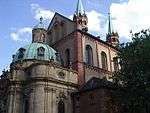
This family counts several prelates of the Roman Catholic Church:
- Johann Philipp von Schönborn (1605–1673), Prince-elector and Archbishop of Mainz, Bishop of Würzburg and Worms. His contemporaries gave him the honourable titles of "the Wise", "the German Solomon", and "the Cato of Germany".
- Lothar Franz von Schönborn, nephew of the above, was Prince-elector and Archbishop of Mainz (1695–1729) and Bishop of Bamberg (1693).
- Damian Hugo Philipp von Schönborn, Prince-Bishop of Speyer (1719–1743) and of Konstanz (1740), and was also a cardinal. He did much for the Diocese of Speyer, and was conspicuous for his culture, learning, and piety.
- Franz Georg von Schönborn, Prince-elector and Archbishop of Trier (1729–1756) and Bishop of Worms (1732). Both Frederick the Great and Maria Theresa praised him as an excellent ruler.
- Johann Philipp Franz von Schönborn, Bishop of Würzburg (1719–1724).
- Friedrich Karl von Schönborn (3 March 1674 – 26 July 1746) was Bishop of Bamberg and Würzburg (1729–1746). He was born at Mainz. The last three prelates were brothers, and nephews of Lothar Franz.
- Franziskus von Paula Graf von Schönborn. (24 January 1844 – 6 June 1899). Born in Prague, he became Archbishop of Prague in 1885, and was created cardinal in 1889.
- Christoph Cardinal Schönborn is the current Archbishop of Vienna.
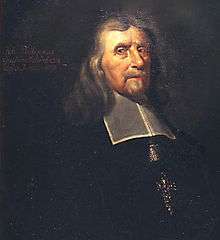 Johann Philipp von Schönborn (1605–1673), Prince-elector and Archbishop of Mainz, Bishop of Würzburg and Worms
Johann Philipp von Schönborn (1605–1673), Prince-elector and Archbishop of Mainz, Bishop of Würzburg and Worms_Lothar_Franz_von_Sch%C3%B6nborn.jpg) Lothar Franz von Schönborn (1655–1729), Prince-elector and Archbishop of Mainz (1695–1729) and Bishop of Bamberg (1693)
Lothar Franz von Schönborn (1655–1729), Prince-elector and Archbishop of Mainz (1695–1729) and Bishop of Bamberg (1693) Johann Philipp Franz von Schönborn (1673–1724), Bishop of Würzburg (1719–1724)
Johann Philipp Franz von Schönborn (1673–1724), Bishop of Würzburg (1719–1724) Friedrich Karl von Schönborn (1674–1746), Bishop of Bamberg and Würzburg (1729–1746), Vice Chancellor of the Holy Roman Empire
Friedrich Karl von Schönborn (1674–1746), Bishop of Bamberg and Würzburg (1729–1746), Vice Chancellor of the Holy Roman Empire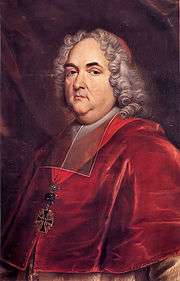 Cardinal Damian Hugo Philipp von Schönborn, Prince-Bishop of Speyer (1719–1743) and of Konstanz (1740)
Cardinal Damian Hugo Philipp von Schönborn, Prince-Bishop of Speyer (1719–1743) and of Konstanz (1740) Franz Georg von Schönborn, Prince-elector and Archbishop of Trier (1729–1756) and Bishop of Worms (1732), Prince-provost of Ellwangen
Franz Georg von Schönborn, Prince-elector and Archbishop of Trier (1729–1756) and Bishop of Worms (1732), Prince-provost of Ellwangen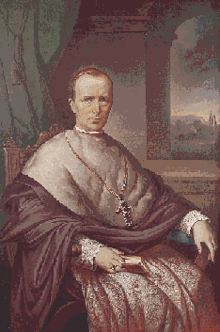 Cardinal Franziskus von Paula Graf von Schönborn (1844–1899), Archbishop of Prague (1885)
Cardinal Franziskus von Paula Graf von Schönborn (1844–1899), Archbishop of Prague (1885)- Christoph Cardinal Schönborn (born 1945), Archbishop of Vienna
Palaces
The House of Schönborn, especially its ruling prelates of the Roman Catholic Church, were among the most important builders of Southern German Baroque architecture. An important art collection is shown at Weissenstein Palace in Pommersfelden, still owned by the Count of Schönborn-Wiesentheid.
- Schönborn, Rhein-Lahn Castle (built around 1100)
- Gaibach Castle (near Volkach), since 1650 to this day owned by the Counts of Schönborn-Wiesentheid
- Geisenheim Castle, since 1652 to this day owned by the Counts of Schönborn-Wiesentheid
- Heusenstamm Castle (built from 1661)
- Schönborner Hof in Mainz (built from 1668)
- Schönborner Hof in Aschaffenburg (built from 1673)
- New Residence in Bamberg (built from 1697)
- Favorite Palace in Mainz (built from 1700)
- Wiesentheid Castle, from 1701 to this day owned by the Counts of Schönborn-Wiesentheid
- Schloss Weißenstein (built from 1711-18), to this day owned by the Counts of Schönborn-Wiesentheid. It houses a famous collection of 17th-19th century musical manuscripts and prints, the "Musical Collection of the Counts Schönborn-Wiesentheid", mainly acquired by Count Rudolf Franz Erwein von Schönborn(1677–1754), a talented amateur cellist who had ordered original cello compositions from various composers including Platti and Vivaldi. This is called the "elder repertoire" and consists of 147 prints and 497 mss. Overview inc. bibliography. Its contents are listed with RISM. The "younger repertoire" was acquired by the cellists grandson resp. grand-grandson, Hugo Damian Erwein (1738–1817) and Franz Erwein von Schönborn (1774–1840). It consists of 141 prints and 98 mss. The whole library has been microfilmed access via DMGA. Reference.
- Göllersdorf Castle, Austria (since 1712 to this day owned by the Counts of Schönborn-Buchheim)
- The Federal Chancellery of Austria, built 1717-1719 for Vice-Chancellor Friedrich Karl von Schönborn
- Würzburg Residence (built from 1719)
- Bruchsal Palace (built from 1720)
- Imperial Chancellory Wing of the Hofburg Palace in Vienna (1723-30 under Vice-Chancellor Friedrich Karl von Schönborn)
- Werneck Castle (built from 1733)
- Palais Schönborn-Batthyány, Vienna (to this day owned by the Counts of Schönborn-Buchheim)
- Palais Schönborn, Laudongasse, Vienna
- Schönborn Palace (Prague)
- Skalka Castle near Vlastislav (Litoměřice District), Czech Republic
- Chynadiyovo Castle, Ukraine
 The New Residence of the Bishops at Bamberg, built 1697-1703 for Lothar Franz
The New Residence of the Bishops at Bamberg, built 1697-1703 for Lothar Franz Favorite Palace at Mainz, built 1700-1722 for Lothar Franz
Favorite Palace at Mainz, built 1700-1722 for Lothar Franz Schloss Weißenstein, built 1711-1718 for Lothar Franz
Schloss Weißenstein, built 1711-1718 for Lothar Franz
.jpg) Bruchsal Palace, built from 1720 for Damian Hugo
Bruchsal Palace, built from 1720 for Damian Hugo Werneck Palace, built 1733-1745 for Friedrich Karl
Werneck Palace, built 1733-1745 for Friedrich Karl Philippsburg Palace at Koblenz, built 1738-1749 for Franz Georg
Philippsburg Palace at Koblenz, built 1738-1749 for Franz Georg
Art collection
See also
- Anna Sophia van Schönborn, a countess of Schönborn, who married a Dutch noble.
- Franziskus von Paula Graf von Schönborn
- Gregor Graf von Schönborn-Wiesentheid, a count of Schönborn and composer of contemporary music.
Notes
External links
-
 Media related to House of Schönborn at Wikimedia Commons
Media related to House of Schönborn at Wikimedia Commons - Official site of the House of Schönborn
- The History of the County of Katzenelnbogen and the First Riesling of the World
